RECOIL OFFGRID Gear Survival Fixed Blade Face-Off
We realize we may sound like a broken record sometimes, since we’re always reiterating the importance of a good fixed-blade knife for survival scenarios. Then again, we only say it because it’s true. If you’re stuck somewhere with little to no resources, and you’ve got a sharp, sturdy knife, you’re already on the right track to collecting food, building a shelter, and defending yourself. There’s only one problem: there are literally thousands of different choices for fixed-blade survival knives. How do you choose what’s best for your needs?
First of all, let’s get something out of the way. Here at OG, we have the privilege of getting our hands on all kinds of handcrafted high-dollar blades. As awesome as those $300+ hand-finished knives can be, most ordinary folks just aren’t looking to spend that much on a piece of sharpened steel. That said, we wanted to come back down to earth and try out some more affordable, sub-$100 mass-market blades. Not everyone is a high-end knife collector, and when it comes to survival blades, you really don’t have to be. They’re going to get scratched and banged up, anyway.
If you walk into any outdoors store or sporting-goods store in the U.S., two brands you’re likely to see on the shelf are Gerber and SOG. That’s not surprising, either, since both companies produce wide ranges of good quality consumer-grade knives and tools. More importantly, both companies produce survival knives that are priced under $100. So, we decided to pick up the latest of these fixed blade knife options from Gerber and SOG, and compare them head to head.

The two knives we’ll be reviewing are the Gerber StrongArm and the SOG Seal Strike. Both are very comparably priced at $86 MSRP for the Gerber and $83 MSRP for the SOG. The SOG also included an optional “Deluxe” sheath that brings its MSRP to $127, but we’ll get into that more later. To start, we’ve created a table below to compare the objective features. Next, we’ll compare our hands-on impressions of the knives, and finally, we’ll draw conclusions.
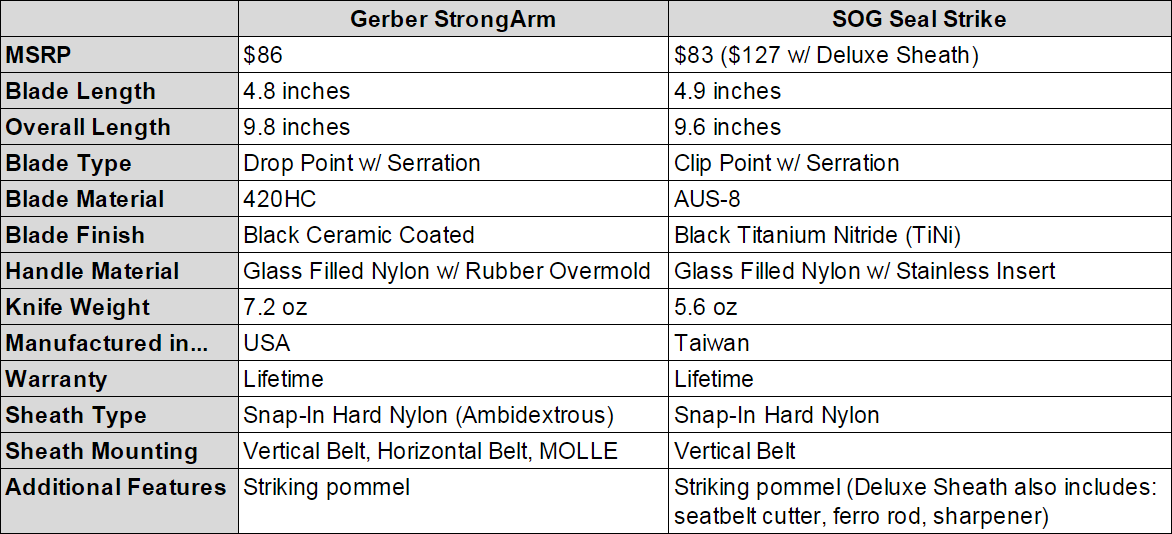
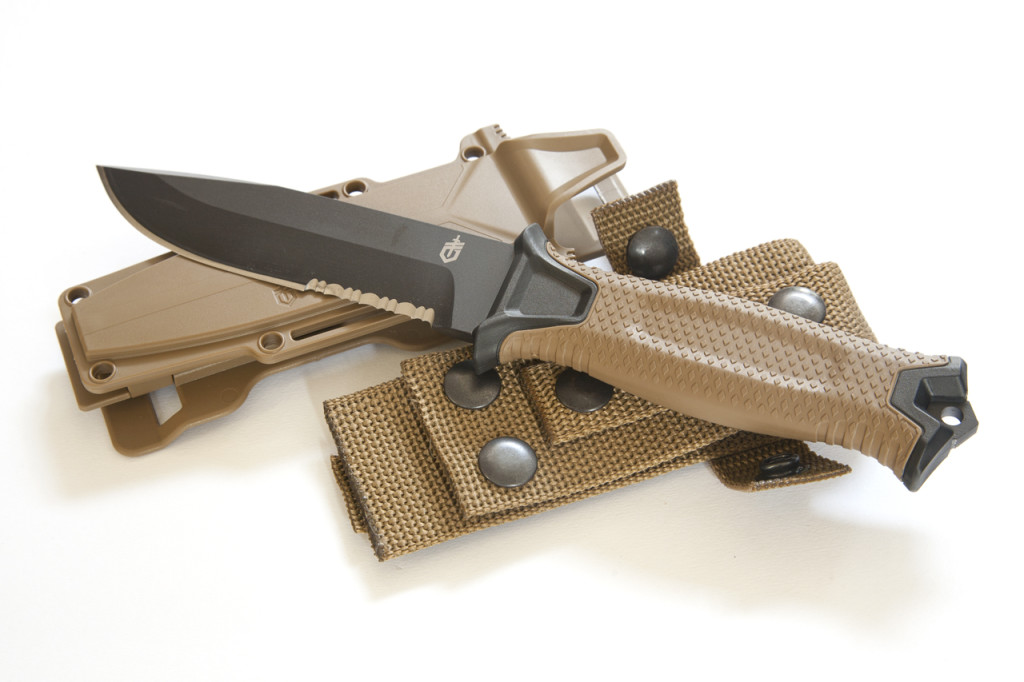
Now that we’ve got the technical side of things out of the way, we unboxed the Gerber StrongArm. Immediately upon grabbing it, the handle became one of our favorite features. Like the SOG, the Gerber handle is composed of strong and light glass-reinforced nylon, but unlike the SOG, the Gerber has a textured rubber overmold around the nylon core. On our StrongArm model, this overmold is Coyote Brown, but Gerber also offers it in black. The rubber’s raised diamond pattern feels pliable and grippy, and it ensures the knife won’t slip when your hands get sweaty or dirty. At the rear of the handle is a pointed steel striking pommel, with a hole that’s perfect for a paracord lanyard or retention strap.
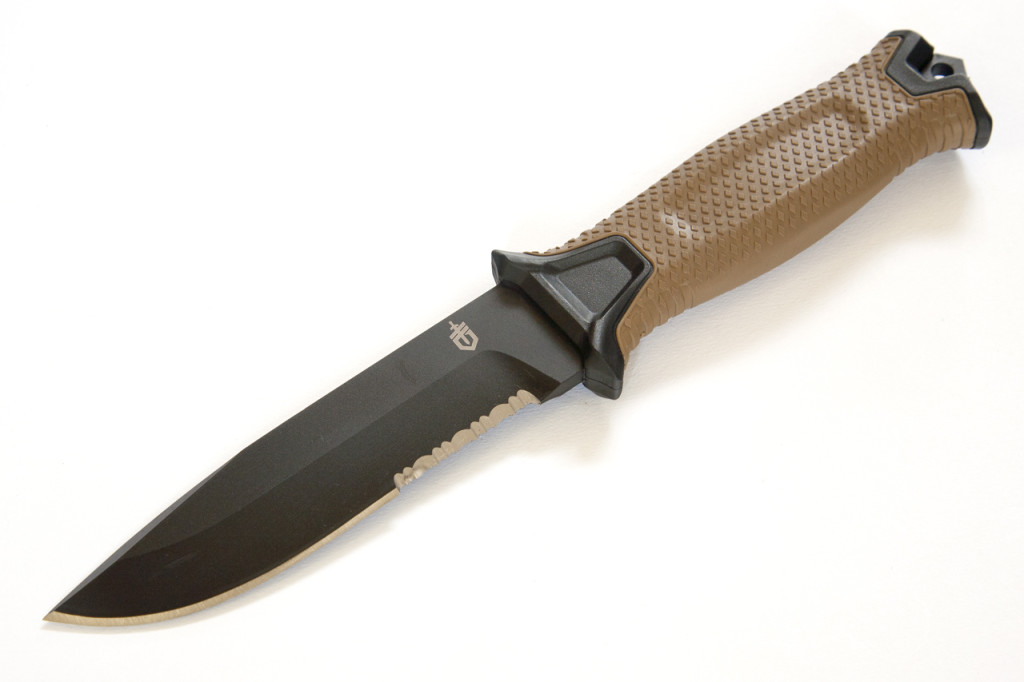
Moving to the business end of the StrongArm, you’ll find a black ceramic-coated 420HC steel blade. The 420HC steel is a mainstay of many survival knives, since it features excellent durability and edge retention, even under heavy use. The blade is quite thick (about 3/16 of an inch) and has reassuring heft—it feels like it could handle some abuse. Our StrongArm features a traditional drop point with a serrated edge, but Gerber also offers a non-serrated version. We did notice that the satin black ceramic finish had several noticeable smudges and discolored blotches, which are visible in our photos of both sides of the knife. Despite our best efforts, these blemishes did not wipe off, as they appear to be baked into the finish. If you’re picky about cosmetics, we could see this being an annoyance. However, the imperfections haven’t seemed to affect the finish’s durability thus far. There’s also “Made in USA, Portland, OR” in large lettering on the blade, and we definitely appreciate that the Gerber was manufactured here in the United States.
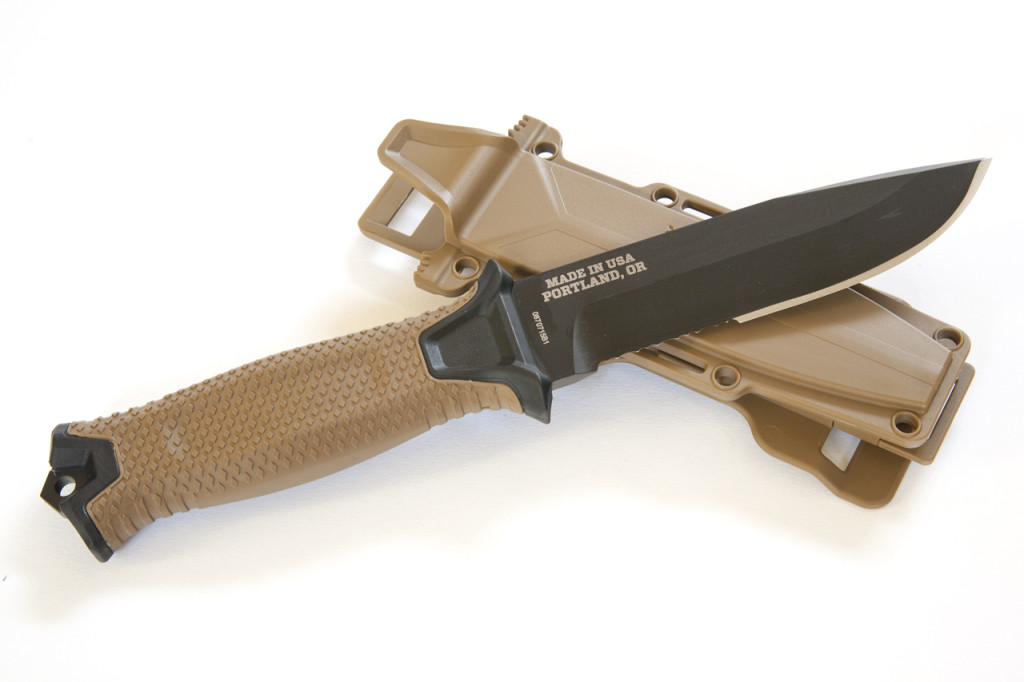
Finally, we tried out the StrongArm’s sheath. Its hard nylon matches the Coyote Brown color of the knife’s handle, and we were pleased to see it’s a fully reversible/ambidextrous design, so the blade can be inserted facing either direction. We also liked the thumb leverage points on either corner of the sheath, which make popping the knife out of its retention notch a snap. The Gerber sheath features several mounting options: vertical (or drop-leg) belt mounting, horizontal belt mounting, and MOLLE compatibility. Getting the MOLLE strap configured correctly is a bit tricky, but it’s a great option to have.
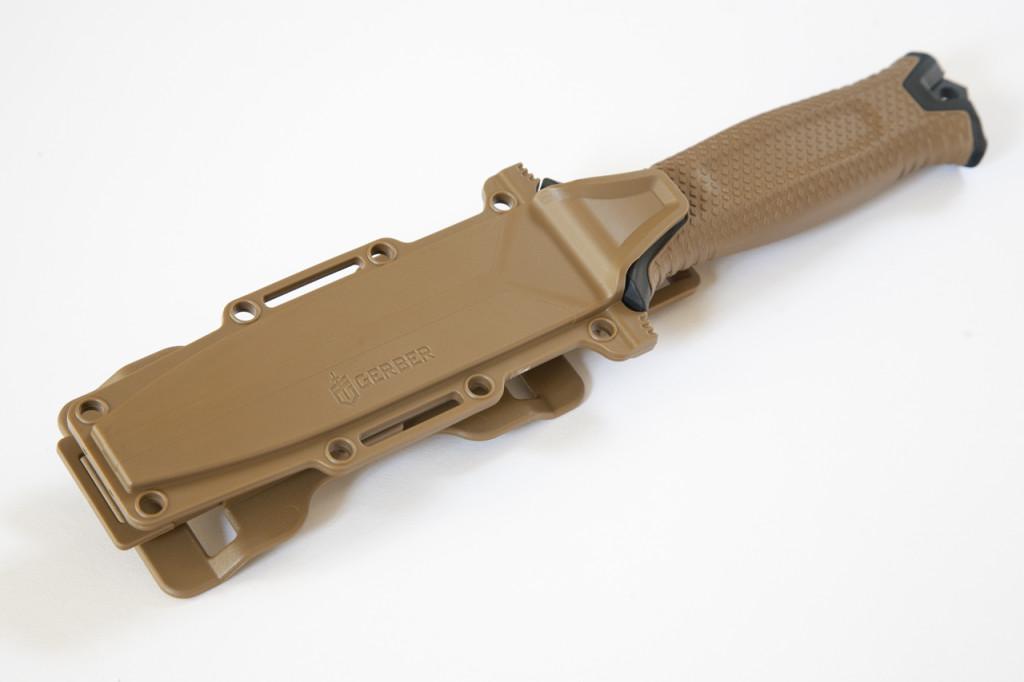

First, a clarification: the SOG Seal Strike we received is the Deluxe Sheath model, which has an MSRP of $127 versus the Standard Sheath model’s $83 MSRP. However, the Deluxe Sheath knife itself only differs from the Standard model in two ways—the Deluxe has a more durable Titanium Nitride finish instead of the Standard’s black powdercoat, and the Deluxe Sheath has several additional survival features built in. So, since the only functional change to the knife itself is the finish, we feel it’s still comparable to the $86 Gerber. After all, you’re mostly paying for the sheath features.

Speaking of sheath features, we’ll address those now. The Deluxe Sheath has a fully rigid nylon design, while the regular sheath has a fabric upper section and button retention strap. The Deluxe sheath also includes three added features: a fire striker ferro rod, a sharpener, and a sliding metal cover that reveals a seatbelt cutter. All these features are certainly nice to have, but we question if they’re worth a $44 premium over the Standard Sheath. Also, despite the helpful added features on the SOG’s Deluxe Sheath, we found its ergonomics were less than perfect. Unlike the Gerber sheath, the SOG sheath’s belt loop extends all the way to the end of the handle. This means you can’t fully grasp the handle as you draw the knife—you have to pinch it with your fingertips and pull.
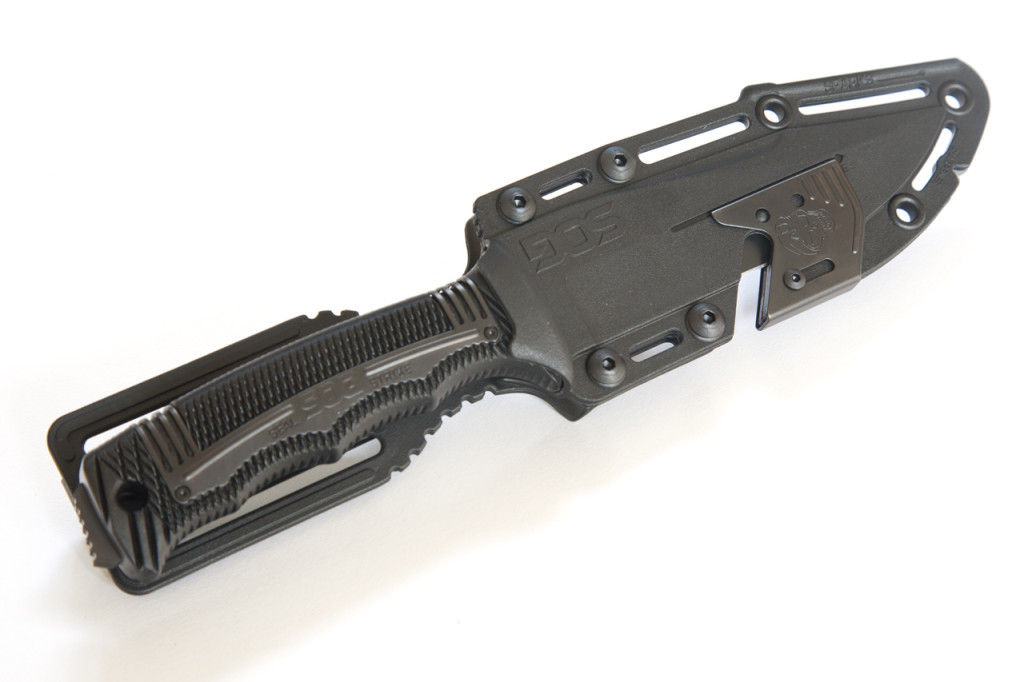
Putting aside the sheath, we gave the Seal Strike a try. Its handle is composed of hard glass-reinforced nylon with a thick crosshatch pattern and a decorative black stainless steel insert. We liked the finger grooves and thumb ridges, but we felt the hard plasticky nylon wasn’t as grippy or comfortable as it could’ve been. The end of the handle has a steel striking pommel and a lanyard hole wide enough for two strands of 550 paracord.
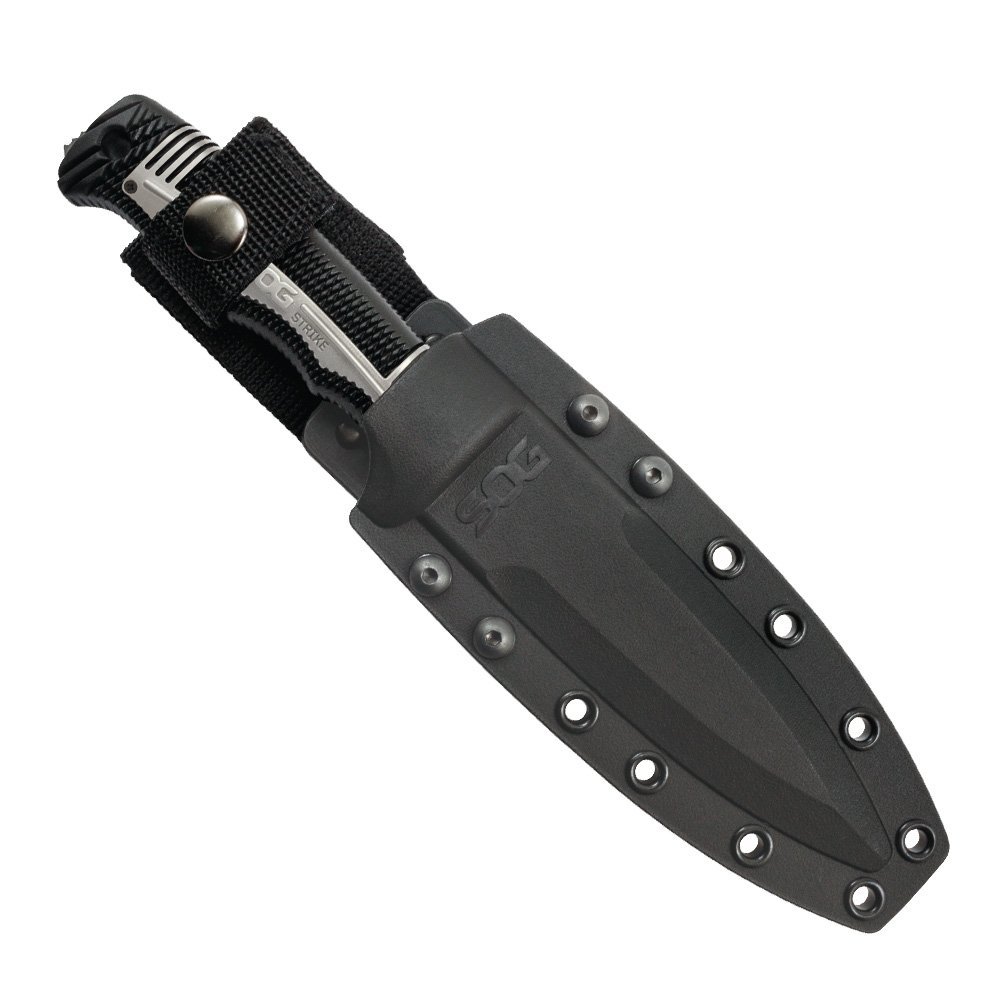
The Seal Strike with Standard Sheath features a hard nylon lower with a soft fabric upper. It also lacks the ferro rod,...
The Seal Strike’s blade is constructed of AUS-8 steel, a material used by SOG on many of their knives. Unlike 440 series steel, AUS-8 also includes vanadium, which improves its wear resistance and helps it take a razor-sharp edge. The Seal Strike blade is relatively thin and lightweight, with a tapered clip point, causing it to feel more like a precision instrument than a hacking and chopping tool. The SOG blade is well-balanced, and its black TiNi finish showed none of the cosmetic imperfections that the Gerber’s ceramic coating had.
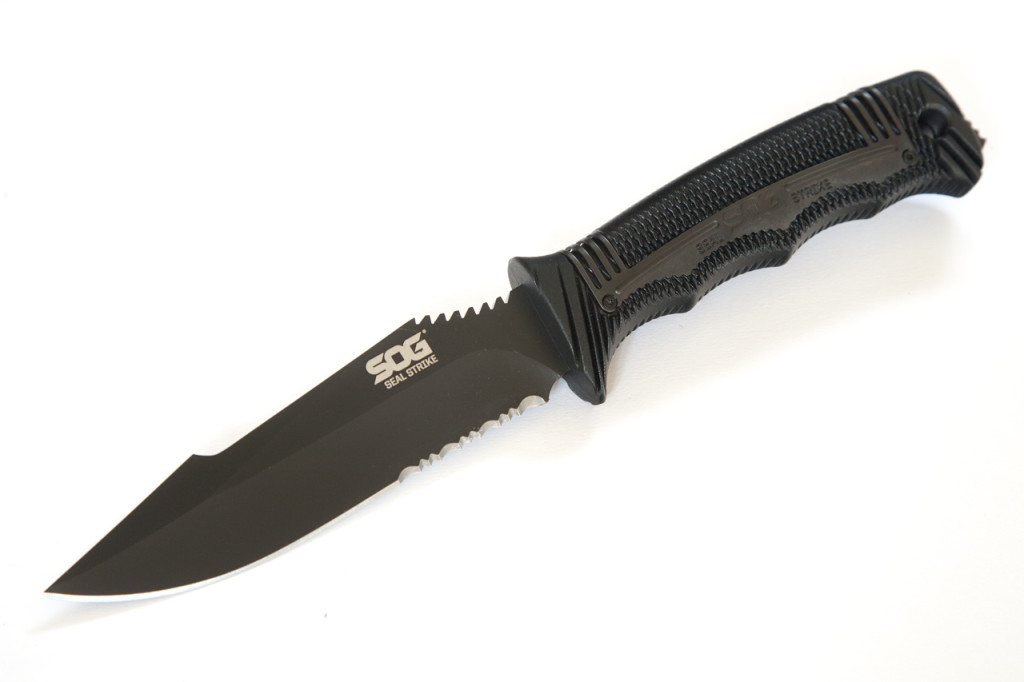
Both the Gerber and the SOG are solid fixed-blade knives, and would likely serve you well in a survival situation. That said, each knife has its strengths and weaknesses. The Gerber’s rubberized handle feels far superior to the SOG’s hard nylon, and we liked the ambidextrous design and versatile mounting options of its sheath. We also preferred the thickness and heft of this knife, as well as the fact that it’s made in the USA. Then again, the blotchy finish was a major disappointment cosmetically.
On the SOG Seal Strike, the nylon handle feels rather cheap, even with the stamped steel insert. We also have a hard time justifying the 53% price increase for the Deluxe Sheath model over the Standard Sheath model. However, the added sheath features are a nice option to have, and the TiNi finish is cosmetically perfect (unlike the Gerber). Also, the Seal Strike’s light weight and tapered blade design make it feel precise and easy to wield.
When it comes down to it, if we had to pick one of the two blades to rely on, we’d go with the Gerber. It’s simply a better ergonomic design—the grippy rubberized handle feels appropriate for a knife in this price range, and the ambidextrous sheath doesn’t get in the way while drawing the knife. All the blemishes in the ceramic finish are ugly, but at least they don’t interfere with functionality. As for the SOG, the Deluxe Sheath model is a good choice if you want the additional survival features in a single package, and spending $44 extra doesn’t bother you. Without the Deluxe Sheath, the SOG Seal Strike is a good knife, but its ergonomic shortcomings prevent it from being truly great.
 STAY SAFE: Download a Free copy of the OFFGRID Outbreak Issue
STAY SAFE: Download a Free copy of the OFFGRID Outbreak Issue
No Comments